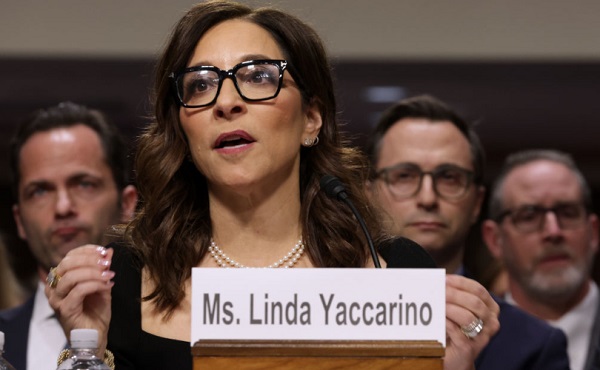Energy
Biden Throws Up One More Last-Minute Roadblock For Trump’s Energy Dominance Agenda


From the Daily Caller News Foundation
By Nick Pope
The Biden administration issued its long-awaited assessment on liquefied natural gas (LNG) exports on Tuesday, with its findings potentially complicating President-elect Donald Trump’s plans to unleash America’s energy industry.
The Department of Energy (DOE) published the study nearly a year after the administration announced in January it would pause approvals for new export capacity to non-free trade agreement countries to conduct a fresh assessment of whether additional exports are in the public interest. While the report stopped short of calling for a complete ban on new export approvals, it suggests that increasing exports will drive up domestic prices, jack up emissions and possibly help China, conclusions that will potentially open up projects approved by the incoming Trump team to legal vulnerability, according to Bloomberg News.
“The main takeaway is that a business-as-usual approach is neither sustainable nor advisable,” Energy Secretary Jennifer Granholm told reporters on Tuesday. “American consumers and communities and our climate would pay the price.”
Trump has pledged to end the freeze on export approvals immediately upon assuming office in January 2025 as part of a wider “energy dominance” agenda, a plan to unshackle U.S. energy producers to drive down domestic prices and reinforce American economic might on the global stage. It could take the Trump administration up to a year to issue its own analysis, and Bloomberg News reported Tuesday that “findings showing additional exports cause more harm than good could make new approvals issued by Trump’s administration vulnerable to legal challenges.”
Republican Washington Rep. Cathy McMorris Rodgers slammed the study as “a clear attempt to cement Joe Biden’s rush-to-green agenda” in a Tuesday statement and asserted that the entire LNG pause was a political choice meant to appease hardline environmentalist interests.
Notably, S&P Global released its own analysis of the LNG market on Tuesday and found that increasing U.S. LNG exports is unlikely to have any “major impact” on domestic natural gas prices, contradicting a key assertion of the DOE’s brand new study. Members of the Biden administration were reportedly influenced by a Cornell University professor’s questionable 2023 study claiming that natural gas exports are worse for the environment than domestically-mined coal, and officials also reportedly met with a 25-year old TikTok influencer leading an online campaign against LNG exports before announcing the pause in January 2024.
“It’s time to lift the pause on new LNG export permits and restore American energy leadership around the world,” Mike Sommers, president and CEO of the American Petroleum Institute, said of the new DOE report. “After nearly a year of a politically motivated pause that has only weakened global energy security, it’s never been clearer that U.S. LNG is critical for meeting growing demand for affordable, reliable energy while supporting our allies overseas.”
Anne Bradbury, CEO of the American Exploration and Production Council, also addressed the DOE’s report in a statement, advising the public to be skeptical of Biden administration efforts to play politics with natural gas exports.
“There is strong bipartisan support for U.S. LNG exports because study after study shows that they strengthen the American economy, shore up global security, and advance collective emissions reductions goals – all while US natural gas prices remain affordable and stable from an abundant domestic supply of natural gas,” said Bradbury. “U.S. LNG exports have been a cornerstone of global energy security, providing reliable supplies to allies and reducing emissions by replacing higher-carbon fuels abroad, and it is critical that any study or policy impacting this vital sector should reflect thorough analysis and active collaboration with all stakeholders. Further attempts by this administration to politicize or distort the impact of U.S. LNG exports should be met with skepticism.”
Automotive
Federal government should swiftly axe foolish EV mandate

From the Fraser Institute
Two recent events exemplify the fundamental irrationality that is Canada’s electric vehicle (EV) policy.
First, the Carney government re-committed to Justin Trudeau’s EV transition mandate that by 2035 all (that’s 100 per cent) of new car sales in Canada consist of “zero emission vehicles” including battery EVs, plug-in hybrid EVs and fuel-cell powered vehicles (which are virtually non-existent in today’s market). This policy has been a foolish idea since inception. The mass of car-buyers in Canada showed little desire to buy them in 2022, when the government announced the plan, and they still don’t want them.
Second, President Trump’s “Big Beautiful” budget bill has slashed taxpayer subsidies for buying new and used EVs, ended federal support for EV charging stations, and limited the ability of states to use fuel standards to force EVs onto the sales lot. Of course, Canada should not craft policy to simply match U.S. policy, but in light of policy changes south of the border Canadian policymakers would be wise to give their own EV policies a rethink.
And in this case, a rethink—that is, scrapping Ottawa’s mandate—would only benefit most Canadians. Indeed, most Canadians disapprove of the mandate; most do not want to buy EVs; most can’t afford to buy EVs (which are more expensive than traditional internal combustion vehicles and more expensive to insure and repair); and if they do manage to swing the cost of an EV, most will likely find it difficult to find public charging stations.
Also, consider this. Globally, the mining sector likely lacks the ability to keep up with the supply of metals needed to produce EVs and satisfy government mandates like we have in Canada, potentially further driving up production costs and ultimately sticker prices.
Finally, if you’re worried about losing the climate and environmental benefits of an EV transition, you should, well, not worry that much. The benefits of vehicle electrification for climate/environmental risk reduction have been oversold. In some circumstances EVs can help reduce GHG emissions—in others, they can make them worse. It depends on the fuel used to generate electricity used to charge them. And EVs have environmental negatives of their own—their fancy tires cause a lot of fine particulate pollution, one of the more harmful types of air pollution that can affect our health. And when they burst into flames (which they do with disturbing regularity) they spew toxic metals and plastics into the air with abandon.
So, to sum up in point form. Prime Minister Carney’s government has re-upped its commitment to the Trudeau-era 2035 EV mandate even while Canadians have shown for years that most don’t want to buy them. EVs don’t provide meaningful environmental benefits. They represent the worst of public policy (picking winning or losing technologies in mass markets). They are unjust (tax-robbing people who can’t afford them to subsidize those who can). And taxpayer-funded “investments” in EVs and EV-battery technology will likely be wasted in light of the diminishing U.S. market for Canadian EV tech.
If ever there was a policy so justifiably axed on its failed merits, it’s Ottawa’s EV mandate. Hopefully, the pragmatists we’ve heard much about since Carney’s election victory will acknowledge EV reality.
Daily Caller
Trump Issues Order To End Green Energy Gravy Train, Cites National Security


From the Daily Caller News Foundation
By Audrey Streb
President Donald Trump issued an executive order calling for the end of green energy subsidies by strengthening provisions in the One Big Beautiful Bill Act on Monday night, citing national security concerns and unnecessary costs to taxpayers.
The order argues that a heavy reliance on green energy subsidies compromise the reliability of the power grid and undermines energy independence. Trump called for the U.S. to “rapidly eliminate” federal green energy subsidies and to “build upon and strengthen” the repeal of wind and solar tax credits remaining in the reconciliation law in the order, directing the Treasury Department to enforce the phase-out of tax credits.
“For too long, the Federal Government has forced American taxpayers to subsidize expensive and unreliable energy sources like wind and solar,” the order states. “Reliance on so-called ‘green’ subsidies threatens national security by making the United States dependent on supply chains controlled by foreign adversaries.”
Dear Readers:
As a nonprofit, we are dependent on the generosity of our readers.
Please consider making a small donation of any amount here.
Thank you!
Former President Joe Biden established massive green energy subsidies under his signature 2022 Inflation Reduction Act (IRA), which did not receive a single Republican vote.
The reconciliation package did not immediately terminate Biden-era federal subsidies for green energy technology, phasing them out over time instead, though some policy experts argued that drawn-out timelines could lead to an indefinite continuation of subsidies. Trump’s executive order alludes to potential loopholes in the bill, calling for a review by Secretary of the Treasury Scott Bessent to ensure that green energy projects that have a “beginning of construction” tax credit deadline are not “circumvented.”
Additionally, the executive order directs the U.S. to end taxpayer support for green energy supply chains that are controlled by foreign adversaries, alluding to China’s supply chain dominance for solar and wind. Trump also specifically highlighted costs to taxpayers, market distortions and environmental impacts of subsidized green energy development in explaining the policy.
Ahead of the reconciliation bill becoming law, Trump told Republicans that “we’ve got all the cards, and we are going to use them.” Several House Republicans noted that the president said he would use executive authority to enhance the bill and strictly enforce phase-outs, which helped persuade some conservatives to back the bill.
-

 Also Interesting2 days ago
Also Interesting2 days ago9 Things You Should Know About PK/PD in Drug Research
-

 Business2 days ago
Business2 days ago‘Experts’ Warned Free Markets Would Ruin Argentina — Looks Like They Were Dead Wrong
-

 Business2 days ago
Business2 days agoCannabis Legalization Is Starting to Look Like a Really Dumb Idea
-

 Business2 days ago
Business2 days agoWEF-linked Linda Yaccarino to step down as CEO of X
-

 Business1 day ago
Business1 day agoCarney government should recognize that private sector drives Canada’s economy
-

 Bruce Dowbiggin1 day ago
Bruce Dowbiggin1 day agoThe Covid 19 Disaster: When Do We Get The Apologies?
-

 Automotive2 days ago
Automotive2 days agoAmerica’s EV Industry Must Now Compete On A Level Playing Field
-

 Media1 day ago
Media1 day agoCBC journalist quits, accuses outlet of anti-Conservative bias and censorship






